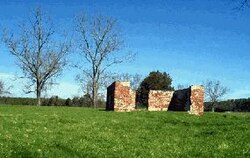Green Spring Plantation
Green Spring | |
 Remains of ancillary jail structure at Green Spring Plantation site | |
| Nearest city | Williamsburg, Virginia |
|---|---|
| Coordinates | 37°15′27″N 76°48′11″W / 37.25750°N 76.80306°W |
| Area | 190 acres (77 ha) |
| Built | 1645 |
| Part of | Colonial National Historical Park (ID66000839) |
| NRHP reference No. | 78000261[1] |
| VLR No. | 047-0006 |
| Significant dates | |
| Added to NRHP | December 29, 1978 |
| Designated VLR | March 19, 1997[2] |

Green Spring Plantation in James City County about five miles (8 km) west of Williamsburg, was the 17th century plantation of one of the more popular governors of Colonial Virginia in North America, Sir William Berkeley, and his wife, Frances Culpeper Berkeley.
Sir William Berkeley, who served several terms, is perhaps the best-known of Virginia's colonial governors. Contrary to popular belief the well-known Berkeley Plantation in nearby Charles City County was not named in his honor.
Today, a section of the land that formed the core of Green Spring Plantation is part of the Colonial National Historical Park.
History
The name Green Spring Plantation originated from the natural spring on the site, which continues over 350 years later to produce huge quantities of very beautifully clear, ultra cold water. The Green Spring produced a flow "so very cold that 'twas dangerous drinking the water thereof in Summer-time," wrote a visitor in the 1680s."
The plantation house at Green Spring was built in 1645. The plantation originally encompassed a 2,090-acre (850 ha) experimental farm.
Seeking alternative export products to supplement tobacco, which had become the Colony's mainstay, Green Spring produced flax, fruits, potash, rice, silk, and spirits, which were shipped to markets in North America, the West Indies, Great Britain, and Holland.
The plantation was owned by Governor William Berkeley until his death in 1677. When Berkeley's widow Lady Frances married Philip Ludwell, ownership passed to him, and then to his son Philip Ludwell II and grandson Philip Ludwell III.
Green Spring Plantation witnessed many historic events, including the beginnings of slavery in Virginia, Bacon's Rebellion in 1676, the Battle of Green Spring during the American Revolutionary War in 1781, the emancipation of its slaves in 1804, by the will of William Ludwell Lee,[3] son of William Lee, and the nearby Battle of Williamsburg in 1862 during the Peninsula Campaign of the American Civil War. A second mansion on the site was burned during the Civil War.
Preservation
In modern times, about 200 acres (81 ha) of the original plantation are preserved by the National Park Service (NPS) as part of the Colonial National Historical Park, which acquired the property in 1966. The site includes archaeological and architectural remnants of the manor house and ancillary structures. It was listed on the National Register of Historic Places on December 29, 1978. It has been argued by historian Virginia B. Price that numerous Virginia county courthouses, including Hanover, King William, and Nelson, are, “arguably, the Green Spring house’s architectural legacy.”[4]
With archaeological work underway, plans call for construction of a parking lot, a small reception center, water and sewer facilities, and a network of trails, planned to be opened by 2008. The project at Green Spring Plantation is supported by NPS partners, Friends of the National Park Service for Green Spring, Inc. and James City County.
See also
References
- ^ "National Register Information System". National Register of Historic Places. National Park Service. July 9, 2010.
- ^ "Virginia Landmarks Register". Virginia Department of Historic Resources. Retrieved 5 June 2013.
- ^ "Ludwells, Lees, and the Promise of the Fourth of July". Ludwell.org. Associates of Colonel Philip Ludwell III, Inc. Retrieved 4 July 2016.
- ^ "Green Spring: The "1600 Pennsylvania" of Its Day". Ludwell.org. Associates of Colonel Philip Ludwell III, Inc. Retrieved 3 June 2016.
External links
- Friends of Green Spring a large interactive web site with streaming video and more than a dozen essays ("The voices of Green Spring")
- National Park Service, Green Spring web page
- Friends of the National Park Service for Green Spring Plantation
- Greenspring, State Route 614 vicinity, Williamsburg, Williamsburg, VA at the Historic American Buildings Survey (HABS)
- Philip Ludwell III and Early American Orthodoxy | Ludwell.org
- Discourse and View of Virginia
- Green Spring Pathway to Freedom
- Protected areas of James City County, Virginia
- James River plantations
- Houses on the National Register of Historic Places in Virginia
- Houses completed in 1645
- National Register of Historic Places in James City County, Virginia
- Colonial National Historical Park
- Historic American Buildings Survey in Virginia
- Houses in James City County, Virginia
- Burned buildings and structures in the United States
- 1645 establishments in Virginia




